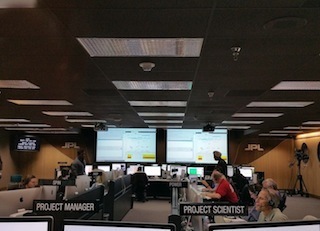NEWS | February 16, 2015
SMAPPING with Erika: Mission Operation

Hi Everyone,
A lot has happened since my last posting. The mission operations team has been hard at work testing the spacecraft and learning its intricacies. Having a new satellite in space is like driving a new car, it takes a little while to learn how it behaves and reacts.
This past week we’ve been testing subsystems and making sure that temperatures and voltages are within range. Also, we have transitioned the spacecraft to point directly at the ground (nadir). While not everything has behaved as expected, the team has addressed some minor yet unexpected issues quickly and is making amazing progress on the objectives of the check out phase. We are now in the process of turning on both instruments, the radar (just the receiver) and the radiometer, for a period of 24 hours to make sure they are working and that data is receivable, readable and making sense.
During this past week we have also tested our communication systems. We have two ways of communicating with SMAP. One is a low rate connection through an S-band link (downlink of 2 and 513 kilobits/second; uplink of 2 and 64 kilobits/second), similar to a phone modem (for those of you who remember those days) and the other is a fast connection (130 megabits/second) through an X-band link, similar to an ultra high-speed Internet line. We use the former as our primary line to communicate with the satellite to send commands up and to receive the “housekeeping” data that monitor the vital signs (temperature, voltages, power, attitude control) of the spacecraft and instrument subsystems. We use the latter to download the instruments’ science data that SMAP will collect. We tested the capability of this link using simulated SMAP data packages and everything worked great.
This past week I visited the mission operations room at JPL. There were about 20 people (at the time) and around a dozen different stations, each one with a specific task (e.g. power, thermal, propulsion) in order to command the spacecraft, review telemetry, and plan future events. At the front of the room there were two giant monitors displaying a schedule of opportunities to communicate with the spacecraft for the next couple of hours as well as the subsystems to be tested on each contact. I was impressed at how smoothly everything flowed and in a way it reminded me of an orchestra where the whole is greater than the sum of its parts.
Next, we are planning on deploying the reflector boom assembly, which will be a major milestone. Keep your fingers crossed, and keep tuned.
Erika




